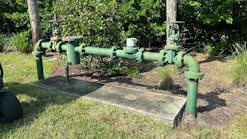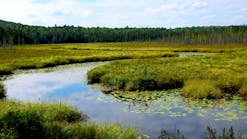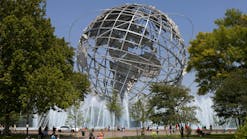In a town known more for its densely packed freeways and high rollers, nature is making a comeback. The Dominguez Gap Wetlands is a 50-acre, multi-use project in Los Angeles County, CA, that pairs municipal responsibilities with leisure activities and greenspace, by incorporating Riverside bike and nature trails with a groundwater treatment and replenishment and stormwater management system. The project, one of five demonstrations projects from the Los Angeles River Master Plan, illustrates that if you build it, they will come.
From Basins to Wetlands
The Dominguez Gap Wetlands are located in Long Beach, CA, on the east side of the Long Beach Freeway, between Del Amo Boulevard and Interstate 405, also known as the San Diego Freeway. From the surface, the area appears to be a nature preserve, wildflowers and tall grasses growing along a sedate body of water, but hidden below–in the soil and root system of the plants–is a water treatment system.
The primary facets of the project are two basins that straddle the Los Angeles River, referred to as the East and West basins. The earthen basins were constructed decades ago, to draw water from the Los Angeles River and allow infiltration into the local aquifer. Stormwater from surrounding urban areas also was also directed to the basins to provide local stormwater management. The basins were operated to hold water and then dry out, repeating this scenario throughout the year. When needed, their floors were scarified, scraped, or abraded to improve infiltration. While the system worked, it served no other purpose other than providing a route to the groundwater.
To understand the importance of the Dominguez Gap Wetlands projects and other river renovations, it helps to know that the Los Angeles River used to be a natural river. Up through the 1800s, the Los Angeles River was the primary source of drinking water for the city. However, flow in the river was inconsistent, nearly negligible in the dry summer season, but during the winter months it often brought a deluge of rain, floods, and destruction. With development along the river expanding, floodwater that normally spread out into flood plains had nowhere to go. It was a series of particularly damaging floods in the early 1900s that lead the charge for controlling the river.
From William Mulholland’s creation of the Los Angeles Aqueduct, which fed the County’s thirst with imported water to Depression Era cheap labor, the river was reigned in. Eventually, the Los Angeles River would be channeled through 51 miles of concrete, from Canoga Park to Long Beach Harbor, and would become nothing more than a storm drain and effluent conduit.
The grumblings started in the 1980, but by 1991 a growing sentiment to utilize the river was acknowledged by the Los Angeles County Board of Supervisors. The Department of Public Works was tasked with developing a proposal to coordinate the interests-from the 13 jurisdictions the river runs through to environmental and neighborhood groups. An advisory committee was appointed, and the Los Angeles River Master Plan was created. Many meetings took place over the years to evaluate needs and options and achieve a consensus on what the plans would entail, including preparation of a feasibility study, conceptual design, and final design.
Jim Bays, senior hydrologist with CH2M HILL, worked on the feasibility plan to determine various remediation scenarios and was involved with the conceptual and final design for the Dominguez Gap Wetlands. After stops and starts along the way, Bays saw the project through fruition in May 2008. His goal was to design wetlands that improve the environment while providing recreational benefits to local citizens. “By design, wetlands meet multiple goals,” says Bays. “It’s harmony between engineering and recreation.”
The Nitty Gritty
As part of the renovation project, the original piping and pumps were left intact. Dry water flows would continue to be drawn from the Los Angeles River for aquifer recharge. In areas surrounding Los Angeles, aquifer recharge generally fills one of two needs. To deter saltwater intrusion, water is pumped into aquifers to increase the hydraulic head, forcing saltwater back toward the ocean. The sole purpose of infiltration at the Dominguez Gap spreading grounds is to support the drinking water aquifer. In this case, improving the quality of water recharging the aquifer ultimately increases the opportunity to provide high-quality drinking water to residents.
A 21-inch corrugated metal pipe draws water from the Los Angeles River at a rate of 3 feet per second, totaling 1.3 million gallons a day. It’s directed to the northern end of the West Basin that-at a mile long-spans 37 acres. Here, nitrogen, phosphorus, and other contaminants are removed or transformed as water meanders through the wetlands, skirting the islands landscaped into the area. Trash is removed using floatable booms to avoid fouling the wetlands.
The Dominguez Gap Wetlands project is one in a series of regional, multi-beneficial projects implemented by the Los Angeles County Flood Control District. Others include the Sun Valley Park and Tuxford Green projects in the Sun Valley Watershed, and the Tujunga Wash Greenway and River Restoration project in the Valley Glen Community in the San Fernando Valley.
Improvements to water quality are geared toward infiltration. Flow from the wetlands and seepage basin does not return to the river. Meaning, any improvements to water quality in the river and Long Beach Harbor are a result of the water, along with its contaminants and trash being removed–not because the water is treated and returned.
Treated water leaves the West Basin via a 42-inch reinforced concrete pipe. A manually adjusted outlet controls flow from the basin. The pipe travels beneath the Los Angeles River, and into the northern end of the East Basin. The 15-acre East Basin is designed to accommodate 450 acre-feet of infiltration annually. Improvements to the basin are not expected to necessarily increase the volume of water replenishing the aquifer, but to improve the quality.
While the new design developed by CH2M HILL did not include an additional piping and pumps, it did require significant earthwork in both basins. Islands were graded into the center of the channel to break up the course of the water and avoid short-circuiting, resulting in adequate treatment time for water flowing through the wetlands. Like any typical wastewater treatment system, design criteria include influent concentrations, removal rates, and detention times.
Approximately 50,000 plants were planted along the slopes, with other areas covered by hydroseeding. The plant selection for the embankments, wetlands, and islands was well planned. Nancy Palmer is a landscape architect who worked with Lynn Capouya Landscape Architects on the project since public input workshops first began. According to Palmer, selecting the vegetation required had to account for a variety of factors.
“The wetland is shaped like a trapezoid,” she says. “The selection of plants for water treatment only affects plants in the water–the cat tails, sedges, and rushes.”
Plants needed for nutrient removal were selected for the bottom of the trapezoid, while the embankments and islands addressed animal needs. Plants that encourage nesting were chosen for the islands, with the understanding that the same nesting birds would feed on the foliage on the banks. This meant vegetation had to be included that birds could either eat, or attract insects the birds could hunt. All of this was done with the surrounding neighborhoods and recreational use in mind.
Because a wetland system is dynamic as plants grow and the environment changes, precise values cannot be easily dialed in. Modeling is done assuming long-term steady state condition, which realistically can take a year or more. Contaminants in the wetland influent are treated in a variety of ways within the system. Bacteria and fungi in the wetland sediments break down nitrogen and biodegradable organics. Phosphorus and metals are not broken down, but adsorbed by wetland plants and sediments.
“With a wetland, we’re dealing with flow, depth, and species,” says Bays. “You can’t just dial in a precise number; there’s always variability. It’s not a traditional wastewater treatment system with knobs and adjustments.”
The project came to a halt several times during the feasibility, design, and construction stages of the project as funds were acquired. The project’s total cost came out to $7 million and was split between different organizations. The Los Angeles County Flood Control District paid $4 million, the State Water Resources Control Board paid $2.3 million, the California Coastal Conservancy paid $400,00, and the River and Mountains Conservancy paid $200,000. The conservancies are state government agencies that purchase, protect, and restore natural areas.
“The project’s open space, water quality improvements, and groundwater recharge make it a cost-effective solution for addressing some of the County’s toughest regional issues,” says County of Los Angeles Supervisor, Don Knabe.
While Dominguez Gap alone may not be able to replenish the aquifer, it’s one of the many projects that the County and other organizations are using to address the water crisis. A growing population, and difficulty in obtaining water, has led municipalities to search harder inside their own watersheds.
Two-thirds of the water supply used by Angelenos comes from northern California and the Colorado River. Kerjon Lee, Public Information Officer for the County of Los Angeles Department of Public Works (LADPW) explains that both sources are threatened by aging infrastructure, climate change, drought, and other natural occurrences. The remaining one-third of Los Angeles County’s water supply comes from local groundwater, surface water, and recycled water.
Drought has become such a problem that, in June 2008, Governor Arnold Schwarzenegger issued Executive Order (EO) S-06-08. The EO cites below-normal rainfall for 2007 and 2008, combined with a decrease in statewide runoff of 41%. Specifically addressed is the decrease in storage of the Colorado River to just over 50% capacity. It’s anticipated that effects of global climate change will greatly impact California’s hydrology with reduced snowpack, altered runoff timing, and changes to the intensity and frequency of droughts in the western US. Because of these concerns, the Governor has given various orders, including an increase in grant funding to local water districts and agencies, assistance with water transfers, aggressive water conservation programs, and prioritizing climate research.
Later in June, the Water Replenishment District (WRD) announced that water imported from northern California and the Colorado River, to replenish aquifers in southeast Los Angeles County, had not been available since the previous May. Delivery of imported water isn’t expected to resume until 2010. Because of local programs used to replenish aquifers like the Dominguez Gap Wetlands project, the aquifers in Los Angeles County are in relatively good shape. The WRD has a goal that by the end of 2015, replacement programs will negate the need to import water for aquifer recharge.
Los Angeles County has seen firsthand the effects of low rainfall and is working with different agencies to address the problem. According to the LADPW, rainfall values for Los Angeles County during the 2006–07 storm season were approximately 78% below average. During the same time frame, the Los Angeles County Flood Control District was only able to conserve about 60% of its average demand, making the importance of projects like the Dominguez Gap Wetlands Project more notable.
“We’re extremely pleased to see the hard work of our watershed advisory groups bearing fruit within the County’s Flood Control District,” says Diego Cadena, Deputy Director of the LADPW. “The Dominguez Gap Wetlands project will have a measurable impact on water quality and return enough water to the groundwater system to meet the supply demands for 900 families of four for one year.”
Added Benefits
As important as aquifer replenishment is in Los Angeles County, so is the need for stormwater control and recreational greenspace. Of which the Dominguez Gap Wetlands project does both. Stormwater from paved, urban areas surrounding the wetlands is directed to the wetlands via a culvert midway up the eastern side. The wetlands store as much water as possible before a massive pump station draws it down, sending excess water directly to the Los Angeles River. At that point, water is diverted to the river as quickly as it enters the basin. The Los Angeles County Flood Control District is responsible for operating the pump stations and ensuring that excess water in the wetlands isn’t allowed to back up into the streets.
During this wet-weather scenario, the wetlands serve only as an equalization basin to alleviate local flooding. It was not designed to, nor can it handle, stormwater from the Los Angeles River or excess stormwater during the winter months. Bays explains that this complicated the design of the wetland system, because it had to operate at two levels. The baseflow comprised of wastewater effluent in the Los Angeles River keeps wetlands wet enough to grow and function as water treatment. But species are needed to be able to tolerate periods of excessive depths when the wetlands are used as storage.
When it came to adding recreational activities to the area, the added benefits weren’t seen as a boon by all involved. It’s reported that the WRD–the agency responsible for routing water from the Los Angeles River into network of basins where it replenishes the aquifer–wasn’t on board with the concept of multi-use purposes of the spreading grounds. The need to maintain the infiltration area without complications from wetlands and walking paths was the reason. The need to improve the water quality was not seen as important as potentially reducing the volume of recharge.
The Los Angeles County Department of Public Works expects removal in the Dominguez Gap Wetlands to be comparable to other wetland sites as summarized below:
- Total nitrogen: 40% to 90%
- Total phosphorus: 10% to 90%
- Total suspended solids: 50% to 90%
- Biological oxygen demand: 50% to 90%
- Heavy metals: 50% to 90%
- Fecal coliform: up to 99%
Bays explains that infiltration volumes for the original design weren’t available, but a small amount of recharge was considered for the wetlands. He designed the system to allow 25% of the water entering the West Basin to infiltrate into the groundwater; the remaining would flow into the East Basin. By providing for minimal seepage in the West Basin, rather than none at all, the WRD acquiesced, and the project moved forward.
Operation and maintenance of the site is planned to ensure that water treatment and infiltration continues. The basins will require weeding to thin out foliage as necessary and remove any invasive species. The East Basin will also continue to be scarified on an as-needed basin. Routing flow from the East to West Basin during the dry cycle and maintaining the basins is the responsibility of the WRD.
White clover has become a nuisance in both basins. “While native plants typically become dormant in the summer dry months, the basins were invaded by white clover, a non-native, invasive species that thrives on our Mediterranean climate,” says Lee. “If these plants are allowed to claim a foothold, they can be devastating to native plant environments, like the wetlands. Over the past few weeks, we have removed the white clover and are prepared to replant the site this winter with natives. We are also monitoring the site closely for any new invasive plants.”
The added greenspace and recreational facilities have not gone unnoticed, particularly around the East Basin. The Los Angeles River and Rio Hondo (LARIO) Trail, created for walkers, bikers, and those on horseback, winds its way through 22 miles of cities and parks and runs along the top of the embankment between the Los Angeles River and the Dominguez Gap Wetlands. Those on foot can veer off the LARIO Trail onto smaller paths that cross different habitats within the east wetlands area. Improvements to the area also include observation platforms and interpretive signs identifying plants and animals that are likely to be seen.
Even before the Dominguez Gap Wetlands project, the LARIO Trail was well-traveled. But with improvements, the area is now more accessible to recreational and educational groups, such as the neighborhood groups who visit the area to walk and bird watch.
As functional spreading grounds, the west side has limited public access, but is a hot spot with the birding community. Now these birders can enjoy the company of other people and possibly other species of birds and animals. While exact revenues haven’t been tallied, it’s expected that birders will spend locally when visiting Dominguez Gap.
Trash is not specifically reduced as a result of treatment within the Dominguez Gap Wetlands, but it is removed by trash booms in the East Basin. Resolution No. 07–012 mandates the amount of trash in the Los Angeles River. Beginning in 2007, the total maximum daily load will have incorporated phased reductions for trash over a period of nine years, from existing baseline loads to zero.
Mary Parsell, Conservation Chair with El Dorado Audubon, was invited by the Native Plant Society to visit the site in April 2008, before the official opening. “It was over the top, like out of a movie,” says Parsell, of the wildflowers that were planted to stabilize the soil. Reeds were planted in the water about five feet apart. These are expected to fill in over time, but, even now, are being claimed.
“We looked very close and saw that red-winged blackbirds had already staked out their territory,” she adds. “We even saw yellow-headed blackbirds, which are rare. After the day I was there, a number of birders reported back that it was gorgeous and very accessible.”
Bays visited the site months after the opening, during late summer of 2008. He witnessed people walking the trail and couldn’t hold back. “I asked them what they thought,” he says, “and they all told me they loved it.”





